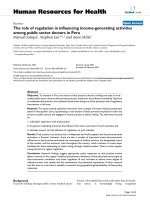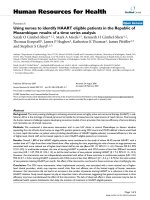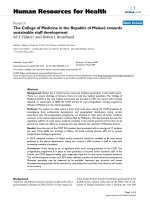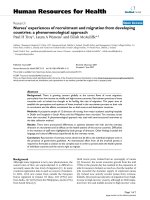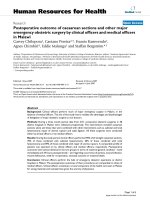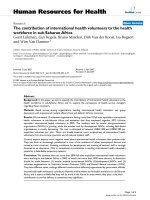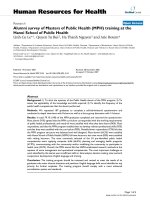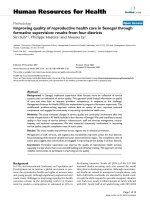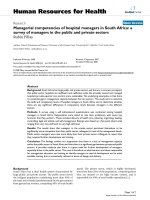Báo cáo sinh học: " Unusual presentation of hepatitis B serological markers in an Amerindian community of Venezuela with a majority of occult cases" doc
Bạn đang xem bản rút gọn của tài liệu. Xem và tải ngay bản đầy đủ của tài liệu tại đây (237.43 KB, 13 trang )
This Provisional PDF corresponds to the article as it appeared upon acceptance. Fully formatted
PDF and full text (HTML) versions will be made available soon.
Unusual presentation of hepatitis B serological markers in an Amerindian
community of Venezuela with a majority of occult cases
Virology Journal 2011, 8:527 doi:10.1186/1743-422X-8-527
Nathalia E Cardona ()
Carmen L Loureiro ()
Domingo J Garzaro ()
Maria C Duarte ()
Daisy M Garcia ()
Milian C Pacheco ()
Isabelle Chemin ()
Flor H Pujol ()
ISSN 1743-422X
Article type Research
Submission date 2 September 2011
Acceptance date 9 December 2011
Publication date 9 December 2011
Article URL />This peer-reviewed article was published immediately upon acceptance. It can be downloaded,
printed and distributed freely for any purposes (see copyright notice below).
Articles in Virology Journal are listed in PubMed and archived at PubMed Central.
For information about publishing your research in Virology Journal or any BioMed Central journal, go
to
/>For information about other BioMed Central publications go to
/>Virology Journal
© 2011 Cardona et al. ; licensee BioMed Central Ltd.
This is an open access article distributed under the terms of the Creative Commons Attribution License ( />which permits unrestricted use, distribution, and reproduction in any medium, provided the original work is properly cited.
Unusual presentation of hepatitis B serological
markers in an Amerindian community of
Venezuela with a majority of occult cases
ArticleCategory :
Research
ArticleHistory :
Received: 2-Sept-2011; Accepted: 01-Dec-2011
ArticleCopyright
:
© 2011 Cardona et al; licensee BioMed Central Ltd. This is an Open
Access article distributed under the terms of the Creative Commons
Attribution License ( which
permits unrestricted use, distribution, and reproduction in any medium,
provided the original work is properly cited.
Nathalia E Cardona,
Aff1
Email:
Carmen L Loureiro,
Aff2
Email:
Domingo J Garzaro,
Aff2
Email:
María C Duarte,
Aff1
Email:
Daisy M García,
Aff1
Email:
Milian C Pacheco,
Aff1
Email:
Isabelle Chemin,
Aff3
Email:
Flor H Pujol,
Aff2
Corresponding Affiliation: Aff2
Email:
Aff1
Servicio Autónomo: Centro Amazónico para la Investigación y Control
de enfermedades Tropicales, Simón Bolívar “CAICET”, Puerto
Ayacucho, Venezuela
Aff2
Laboratorio de Virología Molecular, Centro de Microbiología y
Biología Celular, Instituto Venezolano de Investigaciones Científicas,
Apdo 20632, Caracas 1020-A, Venezuela
Aff3
INSERM U1052 CRCL, Lyon I University, Villeurbanne, France
Abstract
Background
Occult hepatitis B infection (OBI) is characterized by the presence of hepatitis B virus (HBV)
DNA in the absence of HBsAg in the serum of patients. The aim of this study was to characterize
HBV infection among a Piaroa community, an Amerindian group which exhibits significant
evidence of exposure to HBV but relatively low presence of HBsAg, and to explore the presence
of OBI in this population.
Results
Of 150 sera, with 17% anti-HBc and 1.3% HBsAg prevalence, 70 were tested for the presence of
HBV DNA. From these, 25 (36%) were found positive for HBV DNA by PCR in the core
region. Two of these 25 sera were HBsAg positive, indicating an overt infection. Of the
remaining 68 sera tested, 23 exhibited OBI. Of these, 13 were HBV DNA out of 25 anti-HBc
positive (52%) and 10 HBV DNA positive, out of 43 anti-HBc negative (23%), with a statistical
significance of p = 0.03. Viral DNA and HBsAg were present intermittently in follow up sera of
13 individuals. Sequence analysis in the core region of the amplified DNA products showed that
all the strains belonged to HBV genotype F3. The OBI isolates displayed 96–100% nucleotide
identity between them. One isolate exhibited the co-circulation of a wild type variant with a
variant with a premature stop codon at the core protein, and a variant exhibiting a deletion of 28
amino acids.
Conclusions
The frequency of OBI found in this Amerindian group warrants further studies in other
communities exhibiting different degrees of HBV exposure.
Keywords
Hepatitis B virus, Occult infection, Amerindians
Background
Hepatitis B virus (HBV) infection is a significant health concern among Amerindians in the
Americas with high exposure being documented in several Amerindian groups [1]. However, the
prevalence of active HBV infection, defined as positivity for HBV surface antigen (HBsAg) is
variable among different Amerindian communities, coexisting in the same geographic
environment [2]. In a recent study in the Venezuelan Amazon, anti-HBc prevalence ranged from
17 to 70% [2].
Occult hepatitis B virus infection (OBI) is characterized by the presence of hepatitis B virus
(HBV) DNA in the absence of HBV surface antigen (HBsAg) [3,4]. OBI can lead to severe
chronic manifestations including hepatocellular carcinoma (HCC) [5,6]. OBI has not been
studied thoroughly in Amerindian populations and could be present in Amerindian populations
exhibiting evidence of exposure to HBV without high prevalence of active infection. Indeed,
OBI has been already described in Mexican Amerindians [7]. The aim of this study was to
characterize HBV infection among a Piaroa community, an Amerindian group which exhibits
significant evidence of exposure to HBV but relatively low presence of HBsAg [2], and to
explore the presence of OBI in this population.
Results
A total of 150 sera from the Piaroa community Babilla de Pintao were analyzed (Figure 1). Total
anticore antibodies (anti-HBc) prevalence was 17% (26/150) in this group and 31% (25/80) in
individuals over 15 years of age [2]. Only 2 sera (1.3%) were positive for HBsAg [2]. These 2
sera were negative for anti-HBc antibodies. A subset of 70 sera was analyzed for the presence of
HBV DNA. Of these, 25 (36%) were positive for HBV DNA by PCR in the core region (Figure
1). All individuals showed normal ALT levels. The 2 HBsAg sera were positive for HBV DNA.
Of the remaining 23 sera, 13 were anti-HBc positive, and 10 were both anti-HBc and HBsAg
negative. Among the HBsAg negative sera, 52% of the anti-HBc positive and 23% of the anti-
HBc negative sera were HBV DNA positive, this difference being statistically significant (p =
0.03). HBV DNA was found even more frequently among anti-HBs positive individuals
compared to anti-HBs negative ones (p = 0.01) (Figure 1). No difference was observed in the
prevalence of OBI according to sex (9/25 of females and 16/41 of males had HBV DNA in their
sera, p = 0.99), or to age (9/30 younger than 30 years vs. 12/25 older, p = 0.26).
Figure 1 HBV DNA detection according to the HBV serological profile in Piaroa Amerindians
Follow up sera were available for 13 individuals positive for HBV DNA. Viral DNA and HBsAg
were present intermittently, as shown in Table 1. The two individuals presenting with an overt
HBV infection at the beginning of the study, developed OBI later, since they carried HBV DNA
in their sera for more than 2 years without the presence of HBsAg. The HBV genomic region
that could readily be amplified was the core region, while the S region could be amplified only in
some sera (Table 1). From the sera collected from vaccinated subjects in 2009, 34/36 showed
levels of anti-HBs antibodies higher than 10 mIU/ml.
Table 1 HBV DNA in sera from Piarao Amerindians
Serum
Collected April 2002 Collected March 2003 Collected August 2004
Serological
status
1
Core
2
DNA
S
2
DNA
Serological
status
1
Core
2
DNA
S
2
DNA
Serological
status
1
Core
2
DNA
S
2
DNA
BP131
S +, AC - + - S -, AC- + + S +, AC - + -
BP132
S +, AC + - S -, AC- + - S -, AC+ + -
BP11
S -, AC+ +
BP14
S -, AC+ +
BP19
S -, AC+ + S -, AC+ + +
BP29
S -, AC+ + +
BP31
S -, AC+ +
BP43
S -, AC+ +
BP88
S -, AC+ + -
BP89
S -, AC+ +
BP97
S -, AC+ + + S -, AC+ +
BP113
S -, AC+ +
BP117
S -, AC+ +
BP152
S -, AC+ +
BP168
S -, AC+ +
BP21
S -, AC- + - S -, AC- + +
BP74
S -, AC- + - S -, AC- + -
BP92
S -, AC- + - S -, AC- + -
BP134
S -, AC- + - S -, AC- +
BP136
S -, AC- + - S -, AC- + -
BP147
S -, AC- + + S+, AC+ + + S -, AC+ + -
BP150
S -, AC- + -
BP154
S -, AC- + - S -, AC- + - S +, AC- + -
BP156
S -, AC- + - S -, AC- + + S -, AC- + -
BP164
S -, AC- + + S +, AC- + S -, AC- + -
1: Serological status: S (HBsAg), AC (anti-HBc). 2: PCR of the core (C) or surface antigen (S)
region. Blank cells mean not determined
Sequence analysis in the core region of the DNA amplified products showed that all the strains
belonged to HBV genotype F3 (Figure 2). The OBI isolates displayed 96–100% nucleotide
identity between them. The isolates were also closely related to sequences from HBV isolates
circulating among other Piaroa, Yanomami and Yucpa Amerindians exhibiting overt infections
and analyzed in previous studies [8]. One isolate, BP21, exhibited co-circulation of a wild type
virus along with a variant harboring a premature stop codon at aa 42 of the core protein, and a
variant exhibiting a deletion of 28 aas (aa 78–105) (Figure 3). A partial S genomic sequence was
also available for 8 specimens. The sequences in the S region indicate the presence of HBV
genotype F3, subtype adw4, although the length of the genomic region analyzed did not permit
firm subgenotyping. Mutations associated with escape from antibody neutralization were not
observed (data not shown). All the OBI strains were genetically related (Figure 2). Interestingly,
19/25 specimens of OBI shared at least one parent exhibiting OBI.
Figure 2 Phylogenetic tree of HBV core gene region (438 nt). Isolates are designated by their
GenBank accession number, except for Venezuelan isolates. Bootstrap values for the genotype
and cluster branching are shown in the tree. Letters in bold indicate genotype and subgenotype.
Venezuelan HBV isolates circulating in other Amerindians populations were included, from the
Orinoco Delta (DELTA), in Yucpas (JAPREIRA) and in Yanomamis (Y) and Piaroas (P) from
the Amazon (AMAZ)
Figure 3 HBV core variants circulating in a Piaroa Amerindian with OBI. a Agarose gel
electrophoresis of HBV core amplicons. BP21 repeated amplifications of isolate BP21 allow
identifying several variants, each one more frequently found in one amplicon. BP21
1
variant
carrying a deletion in the core region (309 nt). BP21
2
variant carrying a premature stop codon
and a deletion. BP21
3
wild type variant (393 nt). b Amino acid alignments of the core region
amplified in several isolates. Numbers indicate the aa position. Stop codon (*) and deletion (…)
are shown
Discussion
HBV DNA was analyzed in an Amerindian population exhibiting moderate prevalence of
infection (17% anti-HBc), compared to other Venezuelan Amerindian populations, such as that
of the Yanomami (58% anti-HBc). As described previously, this community showed a lower rate
of acquisition of anti-HBc antibodies (1.4% in individuals less than 15 years old), compared to
the Yanomami for example (38% in individuals less than 15 years old) [2]. The lower prevalence
of HBV exposure and infection in this Amerindian community may be due to its geographic
location, since being located near the main urban centre of the state, it is closer to health services.
In addition, a more frequent contact with other civilizations may have modified some socio-
cultural practices, leading to a reduction in HBV transmission, together with more effective
accomplishment of vaccination programs. Despite the lower rate of HBV acquisition, this
community still exhibited a 17% prevalence of anti-HBc antibodies, with a low prevalence of
HBsAg positivity. OBI was shown in this Piaroa population, both in individuals with HBV
serological markers and, with less frequency, in individuals with silent exposure to infection.
Follow-up analysis in 15 individuals confirmed the presence of OBI, since HBV DNA could be
detected in an intermittent form. The frequency of OBI in this community is higher than that
found previously in blood donors from Caracas (4.3%) [9], and in Mexican and North American
Amerindians (14.2% and 9.7% respectively) [7,10], although the methods used to determine OBI
are somehow different between these reports. OBI is common among immunosuppressed
individuals, due either to HIV [11,12], or to other causes [13]. It is important to note that
Amerindians may be immunologically compromised due to multiple parasitic and bacterial
infections, to add to the high prevalence of HBV exposure [14]. As expected, the prevalence of
OBI infection was also higher when HBV serological markers of previous exposure (anti-HBc
and/or anti-anti-HBs) were present. In addition, this Piaroa population exhibited a good response
to vaccination as evidenced by the high frequency of seroconversion observed in 2009, after
vaccination.
As anticipated, phylogenetic analysis showed the presence of the HBV genotype F3, and no
particular strain was shown to be associated with OBI pattern, since the isolates were closely
related to HBV isolates circulating in other Piaroa and Yanomami Venezuelan individuals [8]. In
a previous study of Venezuelan blood donors, OBI was significantly associated with a higher
prevalence of genotypes A and D (70%), while genotype F was predominant in overt cases
(76%) [9]. The present study shows that OBI can also be very frequent among individuals
exclusively exposed to HBV genotype F. OBI has been described recently in Nahuas and
Huichol native populations from Mexico, and HBV genotype H was found in several cases [7].
Three studies have reported a predominance of genotype A and particularly D in cases of OBI
[15-17], while in other studies, genotype A was present at a similar prevalence in overt and OBI
infections [18]. Altogether, these studies suggest that OBI appears not to be restricted to a
particular genotype. In our study, one subject was infected by a wild type virus with variants
coding for core defective proteins, a situation already described in Venezuelan blood donors with
OBI [9]. Most of the subjects with OBI were related, suggesting than familiar transmission might
have played a role in this situation. However, the number of samples analyzed and the short
genomic sequence available for study did not allow testing of this hypothesis.
There is accumulating evidence of a pathogenic role for OBI [19]. OBI may contribute to the
progression of liver fibrosis and HCC development [20], thus the potential benefits of antiviral
treatment is in debate [6,21]. As shown in this study and in others, vaccination of those
populations at risk for OBI should be undertaken as it may bring some benefits to these
communities [22].
Conclusions
A high frequency of unusual HBV presentation was found in this Piaroa population. All the
individuals were infected with HBV genotype F3. The OBI isolates displayed a restrained
variability and were similar to the isolates causing overt HBV infection in other Venezuelan
Amerindian groups. The frequency of OBI found in this Piaroa population warrants further
studies in other Amerindian communities exhibiting different degrees of HBV exposure.
Methods
Population group
The Piaroa community of Babilla de Pintao (Amazon State, Venezuela) consists of 169
inhabitants, and 150 sera were analyzed for the presence of HBV serological markers, with
informed consent and under approval of Bioethical Committees of CAICET and IVIC [2].
Individuals were also vaccinated during this period. Testing was performed between 2002 and
2004, and a subset of sera (n = 36) were collected in 2009 to evaluate anti-HBs antibodies.
Serological assays
Sera were tested for HBV markers with commercial assays: HBcAb DIMA™ (DIMA
Diagnostika C.A., Venezuela), Murex HBsAg Version 3 (ABBOTT, Murex Biotech Limited,
UK), Bioelisa anti-HBs (Biokit, S.A., Spain) and IgM anti-HBc by ETI-CORE-IGMK-2
(DiaSorin Ltda., Italy). A sample was considered anti-HBs positive if the levels of anti-HBs
antibodies were higher than 10 UI/ml. ALT were also determined with a commercial assay
(Wiener Lab, Argentina).
PCR and sequencing
A total of 70 sera (2 HBsAg positive, 25 anti-HBc positive and 43 remaining randomly selected)
were analyzed by nested PCR of the core region [9]. A sample was considered positive if it
repeated positive after a second extraction of viral DNA. When enough serum was available,
samples were also amplified by nested PCR in the S region [8]. Purified PCR fragments were
sent to CESAAN (Centro de Secuenciación y Análisis de Acidos Nucleicos, IVIC, Caracas,
Venezuela), for sequencing. Sequences obtained from the Venezuelan isolates were compared
with different reference strains from GenBank and used for phylogenetic analysis. Sequence
alignment and phylogenetic analysis by the Neighbor Joining method (1,000 bootstrap replicas,
genetic distances evaluated with Kimura 2 parameters corrections) were conducted using
DNAMAN 5.2.2 (Lynnon Bio Soft, Canada). Nucleotide sequence data have been deposited in
GenBank database under the accession numbers JN255220-JN255243.
Statistical analysis
Statistical differences were evaluated by the Chi-Squares test with Yates correction, according to
a computerized Epi Info program, version 3.3.2 (Centers for Disease Control and Prevention,
Atlanta, GA).
List of abbreviations
HBV: Hepatitis B virus; OBI: Occult hepatitis B virus infection; HCC: Hepatocellular
carcinoma; HBsAg: HBV surface antigen; anti-HBc: Anticore antibodies
Competing interests
No competing interests.
Authors’ contributions
NEC, CLL and DJG carried out the molecular genetic studies, and participated in the sequence
alignment. NEC, IC and FHP drafted the manuscript. DMG and MCP carried out the
immunoassays. MCD participated in the clinical and epidemiological study. NEC and FHP
participated in the design of the study and performed the statistical analysis. All authors read and
approved the final manuscript.
Acknowledgments
This work was supported by Grant G-2000001493 from FONACIT, Venezuela, and Projet
ECOS-Nord France-Venezuela: V09S02.
References
1. Devesa M, Pujol FH: Hepatitis B virus genetic diversity in Latin America. Virus Res
2007, 127:177–184.
2. Duarte MC, Cardona N, Poblete F, González K, García M, Pacheco M, Botto C, Pujol FH,
Williams JR: A comparative epidemiological study of hepatitis B and hepatitis D virus
infections in Yanomami and Piaroa Amerindians of Amazonas State, Venezuela. Trop Med
Int Health 2010, 15:924–933.
3. Said ZN: An overview of occult hepatitis B virus infection. World J Gastroenterol 2011,
17: 1927–1938.
4. Hollinger FB, Sood G: Occult hepatitis B virus infection: a covert operation. J Viral
Hepat 2010, 17:1–15.
5. Lledó JL, Fernández C, Gutiérrez ML, Ocaña S: Management of occult hepatitis B virus
infection: an update for the clinician. World J Gastroenterol 2011, 17:1563–1568.
6. Owiredu WK, Kramvis A, Kew MC: Hepatitis B virus DNA in serum of healthy black
African adults positive for hepatitis B surface antibody alone: possible association with
recombination between genotypes A and D. J Med Virol 2001, 64:441–454.
7. Roman S, Tanaka Y, Khan A, Kurbanov F, Kato H, Mizokami M, Panduro A: Occult
hepatitis B in the genotype H-infected Nahuas and Huichol native Mexican population. J
Med Virol 2010, 82:1527–1536.
8. Devesa M, Loureiro CL, Rivas Y, Monsalve F, Cardona N, Duarte MC, Poblete F, Gutierrez
MF, Botto C, Pujol FH: Subgenotype diversity of hepatitis B virus American genotype F in
Amerindians from Venezuela and the general population of Colombia. J Med Virol 2008,
80:20–26.
9. Gutiérrez C, Devesa M, Loureiro CL, León G, Liprandi F, Pujol FH: Molecular and
serological evaluation of surface antigen negative hepatitis B virus infection in blood
donors from Venezuela. J Med Virol 2004, 73:200–207.
10. Minuk GY, Sun DF, Uhanova J, Zhang M, Caouette S, Nicolle LE, Gutkin A, Doucette K,
Martin B, Giulivi A: Occult hepatitis B virus infection in a North American community-
based population. J Hepatol 2005, 42:480–485.
11. Martin CM, Welge JA, Shire NJ, Rouster SD, Shata MT, Sherman KE, Blackard JT:
Genomic variability associated with the presence of occult hepatitis B virus in HIV co-
infected individuals. J Viral Hepat 2010, 17:588–597.
12. Mphahlele MJ, Lukhwareni A, Burnett RJ, Moropeng LM, Ngobeni JM: High risk of occult
hepatitis B virus infection in HIV-positive patients from South Africa. J Clin Virol 2006,
35:14–20.
13. Larrubia JR: Occult hepatitis B virus infection: a complex entity with relevant clinical
implications. World J Gastroenterol 2011, 17:1529–1530.
14. Reina-San-Martin B, Cosson A, Minoprio P: Lymphocyte polyclonal activation: a pitfall
for vaccine design against infectious agents. Parasitol Today 2000, 16:62–67.
15. Morsica G, Ancarani F, Bagaglio S, Maracci M, Cicconi P, Cozzi Lepri A, Antonucci G,
Bruno R, Santantonio T, Tacconi L, Baldelli F, Piscopo R, Santoro D, Lazzarin A, D’Arminio
Monforte A; HepaICONA and the ICONA Study Groups: Occult hepatitis B virus infection in
a cohort of HIV-positive patients: correlation with hepatitis C virus coinfection, virological
and immunological features. Infection 2009, 37:445–449.
16. Pinarbasi B, Onel D, Cosan F, Akyuz F, Dirlik N, Cakaloglu Y, Badur S, Besisik F, Demir
K, Okten A, Kaymakoglu S: Prevalence and virological features of occult hepatitis B virus
infection in female sex workers who work uncontrolled in Turkey. Liver Int 2009, 29:227–
230.
17. Weinberger KM, Bauer T, Böhm S, Jilg W: High genetic variability of the group-specific
a-determinant of hepatitis B virus surface antigen (HBsAg) and the corresponding
fragment of the viral polymerase in chronic virus carriers lacking detectable HBsAg in
serum. J Gen Virol 2000, 81:1165–1174.
18. Pourkarim MR, Lemey P, Amini-Bavil-Olyaee S, Houspie L, Verbeeck J, Rahman M, Maes
P, Vanwijngaerden E, Nevens F, Van Ranst M: Molecular characterization of hepatitis B
virus strains circulating in Belgian patients co-infected with HIV and HBV: overt and
occult infection. J Med Virol 2011, 83:1876–1884.
19. Chemin I, Trépo C: Evolution of Hepatitis B and C serum markers: a still challenging
issue. Liver Int 2011, 31:905–907.
20. Shi Y, Wu YH, Wei W, Zhang WJ, Yang J, Chen Z: Association between occult hepatitis
B infection and the risk of hepatocellular carcinoma: a meta-analysis. Liver Int 2001, in
press.
21. Chemin I, Trépo C: Clinical impact of occult HBV infections. J Clin Virol 2005, 34:S15–
S21.
22. Pereira JS, Gonçales NS, Silva C, Lazarini MS, Pavan MH, Fais VC, Gonçales Júnior FL:
HBV vaccination of HCV-infected patients with occult HBV infection and anti-HBc-
positive blood donors. Braz J Med Biol Res 2006, 39:525–531.
150 sera from Piaroa Amerindians
Ages 0-80 years, mean 21.8 years , 52% men
1,3% HBsAg +, 17% anti-HBc +, 26 % anti-HBs
+
Subset of 70 sera
Ages 0-64, 59% men
2 HBsAg +, 25 anti-HBc positive and 43 randomly selected
25 anti-HBc + 45 anti-HBc -
18 anti-HBs +
7 anti-HBs - 5 anti-HBs +
40 anti-HBs -
2 HBs
+
38 HBs
-
9 HBV
DNA +
(50%)
4 HBV
DNA +
(57%)
4 HBV
DNA +
(80%)
2 HBV
DNA +
(100%)
6 HBV
DNA +
(16%)
13/25 HBV
DNA +
(52%)
10/43 HBV
DNA +
(23%)
23/68 OBI
(34%)
Figure 1
AF223962
AF223965
100
AY311369
X69798F
152DELTA
189DELTA
100
75JAPREIRA
80JAPREIRA
100
85
3019AMAZP
BP164-2
BP134
BP74,BP97
BP136
AY311370
BP147,BP150
BP156
BP154
AB036916
AB036920
BP88
BP92
BP131-1
114AMAZY
84
BP132-1
BP29
BP21_DEL
BP21
AB086397
AY090459
AF223963
AB064315
AY090457
100
X75664
AB091256
100
AB033559
AB033558
87
4194BAMAZ
AB064314
90
X51970
100
98
AF160501
AB026815
V00867
94
D00330
100
100
0.05
FIII
FII
FIV
FI
H
F
E
D
A
G
B
C
Figure 2
1 19
AY311370F MDIDPYKEFGASVELLSFLPSDFFPSVRDLLDTASALYRDALESPEHCTPNHTALRQAILCWGELM
BP21
3
BP21
1
BP21
2
a cllissrlfgtystplqpftemr*
BP29
BP74
BP88
BP92
BP134 s
BP136
BP147
BP154
BP156
78 105
AY311370F TLASWVGNNLEDPAARDLVVNYVNTNMGLKIRQLLWFHISCLTFGRETVLEYLVSFGVWIRTPPA
BP21
3
BP21
1
BP29
BP88
BP134
BP156
BP
131
BP
21
1
BP
21
2
BP
21
3
A B
Figure 3
